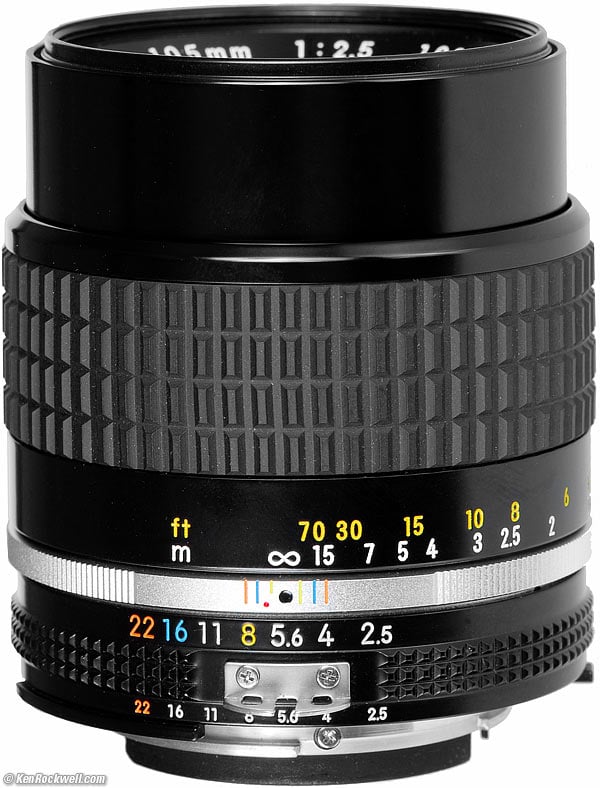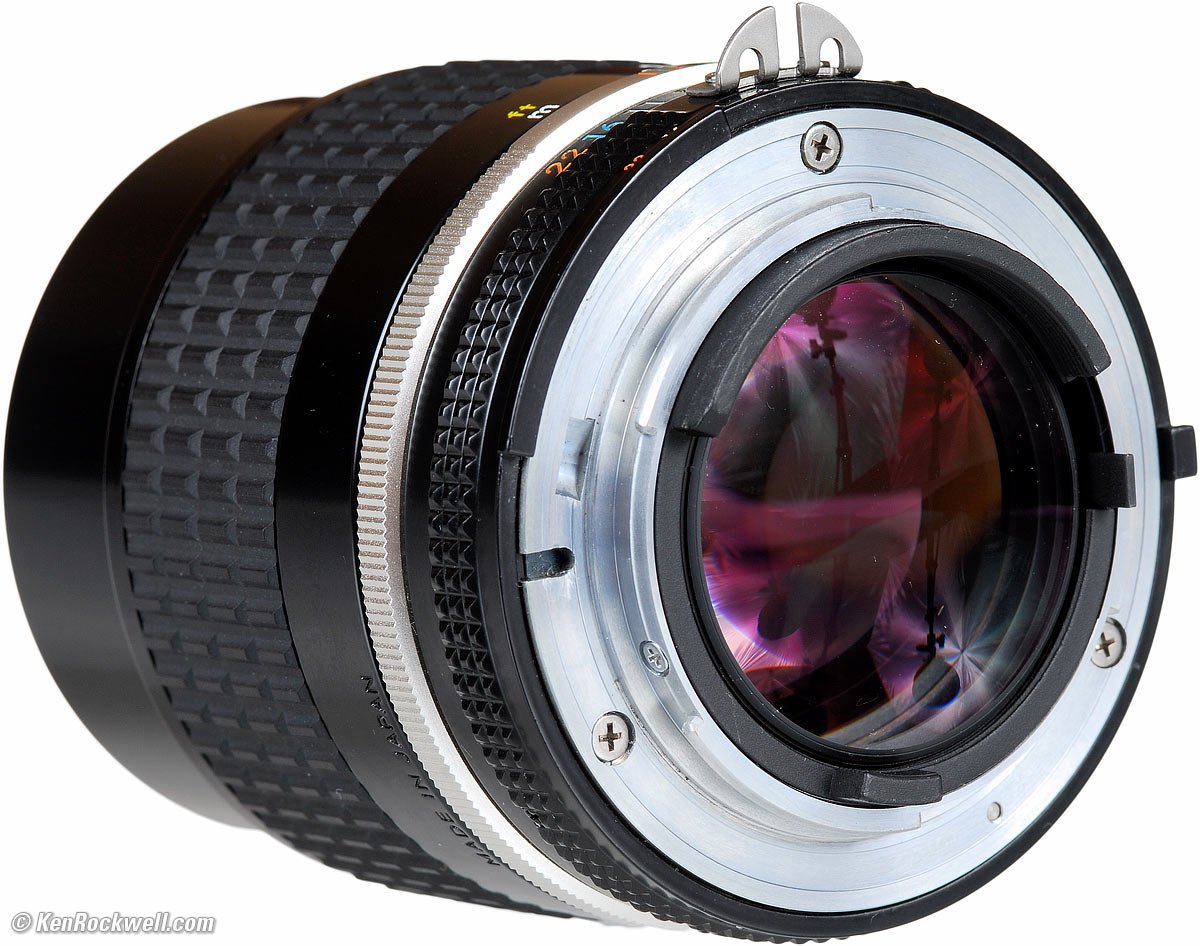Home Donate New Search Gallery Reviews How-To Books Links Workshops About Contact
Nikon 105mm f/2.5
NIKKOR F, AI and AI-s (1971-2005)
© 2013 KenRockwell.com. All rights reserved.
Intro Specifications Performance Compared Recommendations
Nikon 105mm f/2.5 AI-s. (this AI-s version made 1981-2005, FX, DX and 35mm coverage, 52mm filters, built-in telescoping hood, 15.3 oz./435g, 3.3'/1m close focus, about $50-250 used depending on age and condition). This free website's biggest source of support is when you use any of these links, especially these direct links to this lens at eBay (see How to Win at eBay) and used at Adorama when you get anything, regardless of the country in which you live. Thanks! Ken.
August 2013 Nikon Reviews Nikon Lenses All Reviews
Introduction top
Intro Specifications Performance Compared Recommendations
|
Adorama pays top dollar for your used gear. I use these stores. I can't vouch for ads below.
|
This was a popular lens since its introduction in 1959 through about 1990. It has been sold in all the mechanical configurations from the original pre-AI F mount of 1959 through today's superior AI-s version. The optics remain the same.
Only with the adoption of the 80-200 f/2.8 zoom lens by most working professionals around 1990 has the 105 f/2.5 fallen out of most photographers' bags. Therefore you can get them cheap, and even brand new they are very reasonable for what you get.
Of course this is a manual-focus only lens. You have to turn the focus ring for it to focus.
This classic manual focus lens, one of Nikon's greatest of all time. It has no data communication when used on the FTZ so it has no autofocus and very limited usability; use it on an FX DSLR for the best experience (Nikon FX DSLRs have technology lacking in the FTZ for full communication with manual-focus lenses).
This 105 2.5 has come in both traditional Nikon F mount (1959-1976) and Automatic Indexing AI and AI-s mount (1977-2005).
It it's AI, AI-s or converted to AI, it works great with most Nikon cameras, 35mm and digital. If it's a pre-1977 lens and hasn't been converted (most have), it will only work on Nikon cameras made before 1977.
Presuming you have an AI, AI-s or converted lens, it works flawlessly with every manual focus Nikon ever made, from the original Nikon F of 1959 through the FM3a and today's FM-10.
On the D4, D800, D800E, D600, D3X, D3s, D3, D7100, D7000, D700, D300, D200, D2 and F6, use the "Non-CPU Lens Data" menu option to set 105mm and f/2.5 to get full color matrix metering, EXIF data and finder read-out of set aperture. It works great in aperture-preferred as well as manual modes on these cameras.
It works perfectly on every professional 35mm camera (F, F2, F3, F4, F5, F6), and adds Matrix metering on the FA, F4 and F6.
The meters of cheaper digital (D90, D5100 and below) and cheaper film cameras (N80 and below) will not couple (or work at all) with this lens, so you'll be on your own guessing exposure using the rear LCD or an external meter, or get a tiny Gossen Digisix meter and hotshoe adapter, or the free Pocket Light Meter app to meter manually.
See Nikon Lens Compatibility for details on your camera. Read down the "AI, AI-s" column for this lens.
If it is not an AI, AI-s or converted lens, it has much more limited compatibility. Read down the "Pre-AI" column for specific information for use with your particular camera.
Specifications top
Intro Specifications Performance Compared Recommendations
Five elements in four groups. Identical optics since 1971 Multicoated since the "C" version of 1973. (The oldest 1959-1971 version not reviewed here uses a different 5 element in 3 group design, which was also so good that it helped establish Nikon's reputation to this very day).
Seven-bladed diaphragm stopping down to f/22.
Closest focus 1m.
Takes 52mm filters.
Built-in telescoping hood.
It's 2.5" (64mm) around by 3.1" (78mm) long and weighs 15 oz. (435g).
The 1969 non-AI version weighs 375.8g or 13.260 oz. and is 2.550" (64.73 mm) long x 2.599" (66.02mm) diameter.
Made in Japan.
Performance top
Intro Specifications Performance Compared Recommendations
THis 105mm is so good that it is partly responsible for Nikon's reputation and dominance in the professional market back in its day. If you can't make a sharp picture with this lens, it's your fault.
It's sharp at all apertures in all points of the image.
Its light falloff goes away by f/5.6.
This lens has no internal optical stabilization, however it works with internal sensor-shift Image Stabilization (IS or VR (Vibration Reduction)) in some of Nikon's mirrorless Z cameras with the FTZ adapter.
"Percent Perfectly Sharp Shots" are the percentage of frames with 100% perfect tripod-equivalent sharpness I get when I'm shooting hand-held while free-standing with no support or bracing. This is a very strict test; in actual shooting at typical print sizes I get acceptable sharpness at much slower speeds, but for the purposes of seeing how much improvement an IS system gives, this is the most precise method.
Hand tremor is a random occurrence, so at marginal speeds some frames will be perfectly sharp while others will be in various stages of blur — all at the same shutter speed. This rates what percentage of shots are perfectly sharp, not how sharp are all the frames:
| % Perfectly Sharp Shots | 1/2 |
1/4 |
1/8 |
1/15 |
1/30 |
1/60 |
1/125 |
1/250 |
1/500 |
| Stabilization ON | 0 |
0 |
0 |
33 |
100 |
100 |
100 |
100 |
100 |
| Stabilization OFF | 0 |
0 |
0 |
0 |
0 |
17 |
67 |
100 |
100 |
I see about a 2⅔ stop real-world improvement.
Compared top
Intro Specifications Performance Compared Recommendations
Compares to the 105 f/1.8
I never have seen any difference between the 1.8 and 2.5, even when making direct comparison tests. Therefore in real photography there will be no visible difference at all, save for the availability of maximum aperture and less vignetting at the same larger apertures with the f/1.8. At f/5.6 and smaller there is no difference at all. Photodo.com MTF tested slightly higher values for the f/1.8 on a machine, but these are too close to make any visible difference.
I bought a couple of these while I had my 105mm f/1.8 in the 1980s. The f/2.5 has such folklore behind it I thought it had to be better. Nope. In each case it was the same as my 105mm f/1.8, so I returned the f/2.5s. Now with the MTF tests posted at Photodo.com we can discern fact from folklore: the 1.8 is a bit sharper.
Rear, Nikon 105mm f/2.5 AI-s. bigger.
Recommendations top
Intro Specifications Performance Compared Recommendations
This is a great lens and therefore has no flaws to write about. If you want one, buy one. They are all over the place second hand.
The Nikon 105mm f/2.5 AI-s is a manual-focus only lens.
Personally I prefer the field of view of an 85mm or the speed of the 105mm f/1.8, but I'm weird. The newer (since 1977) versions of the 105mm f/2.5 have a handy built-in lens hood and they all take the standard 52mm filters. They are all compact and super sharp, but no more so than the equally superior 85mm f/2.0 and 105mm f/1.8.
Don't confuse this lens with the cheap 100mm f/2.8 Series E. The Series E was a discount lens from the late 1970s. It's swell lens optically, but it's odd to see people pay as much for the Series E as they will for this mechanically superior 105mm f/2.5. This 105 has been a benchmark professional lens for decades and is built to the highest mechanical standard Nikon has ever attained, while the 100mm Series E was somewhat less sturdy, but still optically superb and better than most modern AF lenses.
Deployment top
I'd pitch the flat Nikon cap that came with this lens new, and get a new "pinch" type cap. I'm not kidding: the new fatter caps are much easier to use in the field.
I'd leave either a 52mm Nikon Clear (NC - UV) filter, or a 52mm Hoya Super HMC UV on the lens at all times. I would leave the hood at home.
If I was working in nasty, dirty areas, I'd forget the cap, and use an uncoated 52mm Tiffen UV filter instead. Uncoated filters are much easier to clean, but more prone to ghosting.
For color slides like Velvia 50, I use an old Nikon A2 or new 52mm Hoya HMC 81A outdoors.
For B&W film outdoors, I'd use an old Nikon Y48 or O56, or a new 52mm Hoya HMC K2 Yellow or 52mm Hoya HMC Orange.
Help me help you top
I support my growing family through this website, as crazy as it might seem.
The biggest help is when you use any of these links when you get anything, regardless of the country in which you live. It costs you nothing, and is this site's, and thus my family's, biggest source of support. These places have the best prices and service, which is why I've used them since before this website existed. I recommend them all personally.
If you find this page as helpful as a book you might have had to buy or a workshop you may have had to take, feel free to help me continue helping everyone.
If you've gotten your gear through one of my links or helped otherwise, you're family. It's great people like you who allow me to keep adding to this site full-time. Thanks!
If you haven't helped yet, please do, and consider helping me with a gift of $5.00.
As this page is copyrighted and formally registered, it is unlawful to make copies, especially in the form of printouts for personal use. If you wish to make a printout for personal use, you are granted one-time permission only if you PayPal me $5.00 per printout or part thereof. Thank you!
Thanks for reading!
Ken Rockwell.
Home Donate New Search Gallery Reviews How-To Books Links Workshops About Contact




